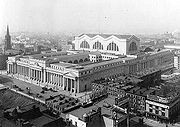
Diocletian window
Encyclopedia
Diocletian windows, also called thermal windows, are large semicircular windows characteristic of the enormous public baths (thermae
) of Ancient Rome
. They have been revived on a limited basis by some classical revivalist architects in more modern times.
s (or other openings) which are usually divided into three lights (window compartments) by two vertical mullion
s. The central compartment is often wider than the two side lights on either side of it.
(AD 302) in Rome
. (The Thermae are now the church of Santa Maria degli Angeli e dei Martiri
.) The variant name, thermal window, also comes from their association with the Thermae of Diocletian.
 This type of window was revived and used in Italy in the 16th century, especially by Andrea Palladio
This type of window was revived and used in Italy in the 16th century, especially by Andrea Palladio
. Palladio and others incorporated an elongated Diocletian window in the form of an arched central light flanked by narrower, square-headed apertures. This combination became known as a Palladian, or Venetian, window.
The Diocletian window was much used in the early 18th century by the English architect Richard Boyle
, 3rd Earl of Burlington
, one of the originators of the English Palladian style, and by his followers.
Diocletian windows continued to be used occasionally in large public buildings in the various devolutions of neoclassical architecture
including the Beaux Arts movement (1880–1920).
Thermae
In ancient Rome, thermae and balnea were facilities for bathing...
) of Ancient Rome
Ancient Rome
Ancient Rome was a thriving civilization that grew on the Italian Peninsula as early as the 8th century BC. Located along the Mediterranean Sea and centered on the city of Rome, it expanded to one of the largest empires in the ancient world....
. They have been revived on a limited basis by some classical revivalist architects in more modern times.
Description
Diocletian windows are large segmental arched windowWindow
A window is a transparent or translucent opening in a wall or door that allows the passage of light and, if not closed or sealed, air and sound. Windows are usually glazed or covered in some other transparent or translucent material like float glass. Windows are held in place by frames, which...
s (or other openings) which are usually divided into three lights (window compartments) by two vertical mullion
Mullion
A mullion is a vertical structural element which divides adjacent window units. The primary purpose of the mullion is as a structural support to an arch or lintel above the window opening. Its secondary purpose may be as a rigid support to the glazing of the window...
s. The central compartment is often wider than the two side lights on either side of it.
Names
Diocletian windows are named for the windows found in the Thermae (Baths) of DiocletianBaths of Diocletian
The Baths of Diocletian in Rome were the grandest of the public baths, or thermae built by successive emperors. Diocletian's Baths, dedicated in 306, were the largest and most sumptuous of the imperial baths. The baths were built between the years 298 AD and 306 AD...
(AD 302) in Rome
Rome
Rome is the capital of Italy and the country's largest and most populated city and comune, with over 2.7 million residents in . The city is located in the central-western portion of the Italian Peninsula, on the Tiber River within the Lazio region of Italy.Rome's history spans two and a half...
. (The Thermae are now the church of Santa Maria degli Angeli e dei Martiri
Santa Maria degli Angeli e dei Martiri
The Basilica of St. Mary of the Angels and the Martyrs is a titular basilica church in Rome, built inside the frigidarium of the Baths of Diocletian. The Cardinal priest of the is William Henry Keeler.- The basilica :...
.) The variant name, thermal window, also comes from their association with the Thermae of Diocletian.
Influence

Andrea Palladio
Andrea Palladio was an architect active in the Republic of Venice. Palladio, influenced by Roman and Greek architecture, primarily by Vitruvius, is widely considered the most influential individual in the history of Western architecture...
. Palladio and others incorporated an elongated Diocletian window in the form of an arched central light flanked by narrower, square-headed apertures. This combination became known as a Palladian, or Venetian, window.
The Diocletian window was much used in the early 18th century by the English architect Richard Boyle
Richard Boyle, 3rd Earl of Burlington
Richard Boyle, 3rd Earl of Burlington and 4th Earl of Cork PC , born in Yorkshire, England, was the son of Charles Boyle, 2nd Earl of Burlington and 3rd Earl of Cork...
, 3rd Earl of Burlington
Earl of Burlington
Earl of Burlington is a title that has been created twice, the first time in the Peerage of England and the second in the Peerage of the United Kingdom. The first creation was for Richard Boyle, 2nd Earl of Cork, on 20 March 1664...
, one of the originators of the English Palladian style, and by his followers.
Diocletian windows continued to be used occasionally in large public buildings in the various devolutions of neoclassical architecture
Neoclassical architecture
Neoclassical architecture was an architectural style produced by the neoclassical movement that began in the mid-18th century, manifested both in its details as a reaction against the Rococo style of naturalistic ornament, and in its architectural formulas as an outgrowth of some classicizing...
including the Beaux Arts movement (1880–1920).

